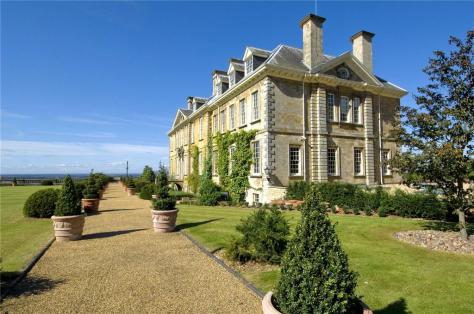A significant country house re-emerges from obscurity, this prestigious Grade II* listed mansion stands in a parkland setting with far reaching views across the Trent and Witham Valleys.

A lot has been said about the views from Harmston Hall, on the Lincoln Cliff overlooking the River Witham. From its parkland, on a clear day, you can see the Derbyshire Hills, some 60 miles or so away. This spectacle is foremost in the estate agent’s selling brief, along with the floors – oak floors, oak floors inlaid with mahogany detailing, and lots of pine floors. Yes. A lot has been made about the wooden floors here.
The oddest thing is that outside the North Kesteven district of Lincolnshire, not many people have heard of Harmston Hall. The fact that it has re-emerged from obscurity is due to it being offered on the open market at Savills with a guide price of £3.45 million.
The land on which it stands once belonged to the Thorold family, resident here since 1456. The present Queen Anne house was started by Sir Charles Thorold (1655-1709), but it was his younger brother, Sir George Thorold who completed it in about 1710. The mansion became the summer retreat of the Lord Mayor of London, a man who acquired a baronetcy and distinguished title ten years later. Sir George added a tall north front to the house, but this was pulled down in 1892 when the family departed Harmston Hall for good.
The buyer was William Henry Morton, a farmer, magistrate and county alderman, who, in 1892, spent a considerable sum of money altering the house, employing Lincoln architects William Mortimer and his son, William Malkinson Mortimer, to carry out the designs. A new front was created in the same style as the original building, incorporating a new entrance and porch, surmounted by a tower. The roof was stripped of its tiles and recovered in green slate, while new windows were added to the upper storeys. Inside, all the rooms were completely renovated, but despite his extravagance, Morton only stayed at Harmston Hall for six years.

The estate was sold in 1898 to Nathaniel Clayton Cockburn, a grandson of Nathaniel Clayton, a Lincoln iron founder. Its new owner was a military man, a Major in the Imperial Yeomanry, who ended up serving in Palestine during World War One. Cockburn died in 1924 and its big rooms briefly became the domain of his sister.
The inevitability was that Harmston Hall was far too big and expensive to maintain. Therefore, it was no surprise when it was sold to the Lincolnshire Board for the Mentally Defective, who opened it as a ‘Colony for Mental Defectives’ in 1935… and consigned the country house to decades of bleak insignificance. Just imagine the despairing shrieks from the inmates echoing through those long corridors. This was a time when Britain wasn’t particularly good at dealing with mental health… many of its occupants probably shouldn’t have been there at all. The hospital was eventually absorbed into the National Health Service (NHS) and buildings spread across the parklands.
Harmston Hall Hospital later became an administrative block and closed for good in 1989.
As always happened, the abandoned hospital was left to decay – broken windows, leaking roof, rotten floors and ceilings – its former institutional use adding to the air of dereliction.

Its saviour was Peter Sowerby, a local property developer, who bought the estate in 1996. There were probably those who thought him mad enough to have been one of the hospital’s former residents. However, when Sowerby flattened the hospital outbuildings and built a new housing development, there appeared to be some wisdom attached to him after all. He doubled the population of Harmston and transformed the quiet village into an important commuter settlement for Lincoln.
Decisively, Harmston Hall itself was restored and turned back into a family home over a period of ten years. In 2008, it was on the market for £4.5 million, considerably more than the guide price being asked for today.
There are few signs of its former use. The house is entered through a panelled entrance lobby with stone flooring. This leads into a Reception Hall, complete with Rococo chimneypiece, Georgian fanlight doorways and Ionic columns in front of the staircase. The principal rooms include the main Drawing Room, along with a former Ballroom (complete with the oak flooring and inlaid mahogany detailing). The Dining Room and yellow Sitting Room all have original Queen Anne wooden panelling with pine and oak floors respectively. An ornate Billiards Room is embellished with mahogany panelling, carvings, huge mahogany doors along with decorative cornices, and, of course, more oak flooring. Upstairs there are seven primary bedrooms.
Being a former Historic Formula 1 Champion, it is no surprise that Sowerby has also included garaging for 20 cars. The big difference from its former existence as a country house is the addition of both an indoor and outdoor swimming pool.
The Grade II* listed house stands within 13-acres of land, including a terraced garden with those spectacular views, and a further 30-acres of former parkland available separately.
All images were taken in 2014.
